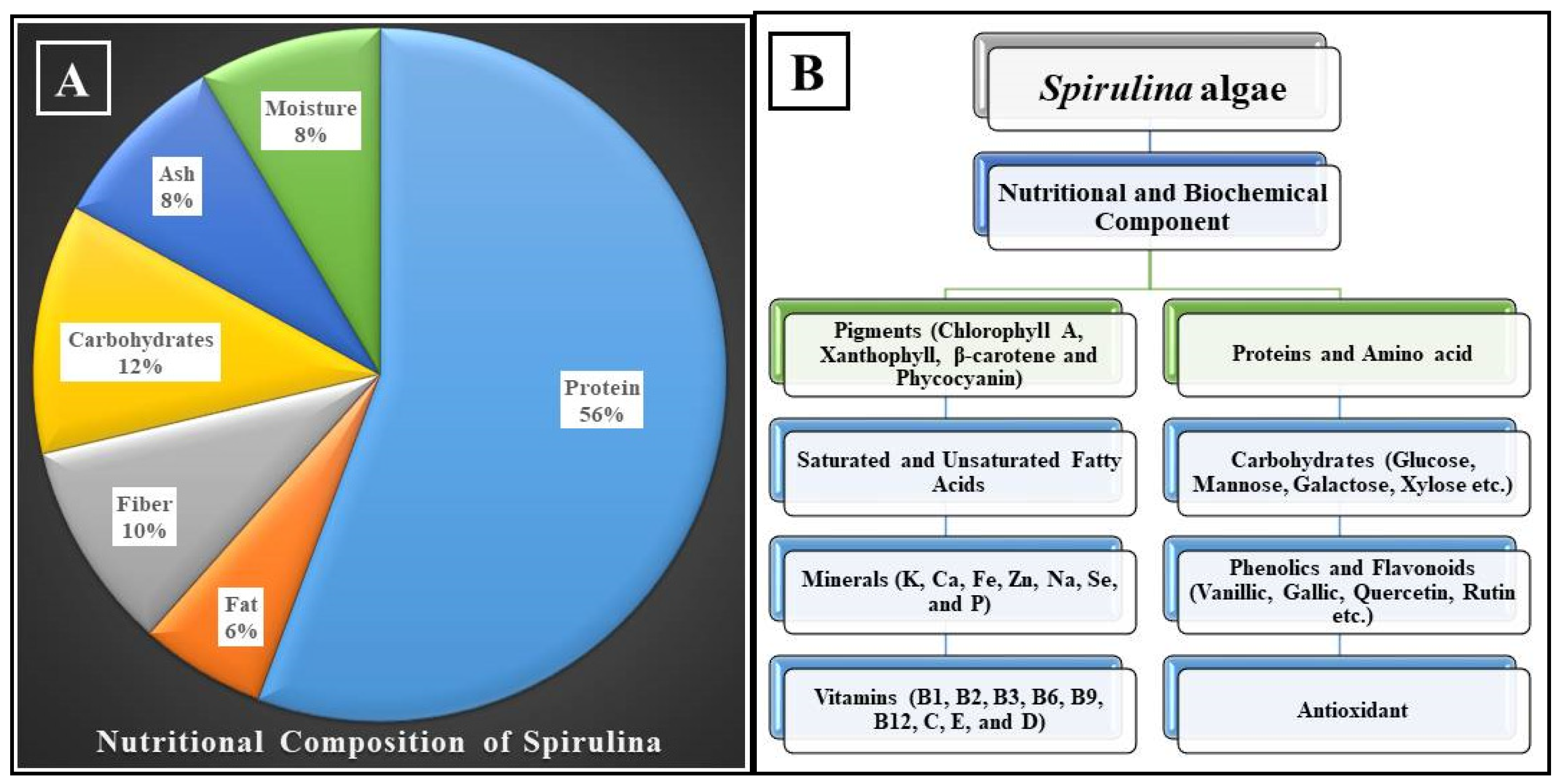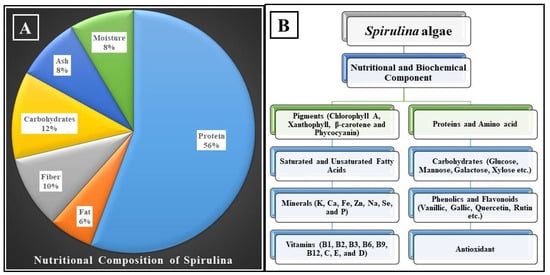You're using an outdated browser. Please upgrade to a modern browser for the best experience.
Please note this is a comparison between Version 1 by Francesco Cacciola and Version 2 by Rita Xu.
Spirulina is a kind of blue-green algae (BGA) that is multicellular, filamentous, and prokaryotic. It is also known as a cyanobacterium. It is classified within the phylum known as blue-green algae. Despite the fact that it includes a high concentration of nutrients, such as proteins, vitamins, minerals, and fatty acids—in particular, the necessary omega-3 fatty acids and omega-6 fatty acids—the percentage of total fat and cholesterol that can be found in these algae is substantially lower when compared to other food sources.
- spirulina algae
- chemical composition
- health and nutritional value
1. Introduction
Spirulina algae, also known as Arthrospira platensis, are members of the class of cyanobacteria (also named blue-green algae) that are classified under the phylum of multicellular organisms. These filaments are unbranched and spiral in shape. Algae are a diverse group of aquatic organisms that have the ability to conduct photosynthesis. In subtropical and tropical climates, such as Hawaii, Mexico, Asia, and Central Africa, they flourish naturally in water tanks that contain high levels of salt and alkaline. GRAS stands for “generally regarded as safe,” which is the designation that the Food and Drug Administration (FDA) has bestowed upon it. Research on humans in clinical trials, as well as studies on animals carried out in the most recent decade, provide credence to this assertion. A. platensis, A. maxima, and A. fusiformis are three of the species of spirulina that have been put to use in food, and have been the subject of a significant amount of research [1][2][3][4][1,2,3,4].
Spirulina algae have high nutritional value. As a result of their high protein content (60–70% on a dry weight basis), vitamins, minerals, essential fatty acids, and other nutrients, the FDA has designated them as the ideal food for mankind and a “super food,” containing high concentrations of beta(β)-carotene, vitamin B12, iron, trace elements, and the extremely rare essential gamma(γ)-linolenic acid. The Food and Agriculture Organization (FAO) of the United Nations have referred to spirulina as a “highly digestible protein product,” and the US space agency has utilized it as a dietary supplement for astronauts. Because of this, spirulina deserves the title of “the food of the future” more than any other food on Earth [1][2][1,2].
It has been demonstrated that spirulina is both biologically and economically significant due to the numerous applications that have been developed for it in the food, pharmaceutical, biofuel, cosmetics, and agricultural industries. These algae are readily accessible for purchase and have a significant geographic distribution. This is because the manufacturers want to obtain the biomass of spirulina in order to make use of its important biologically active compounds, such as phycocyanins, phenols, polysaccharides, polyunsaturated fatty acids (PUFAs), carotenoids, vitamins, and sterols. This is why there is such a high demand for spirulina. The majority of these compounds play an important therapeutic role in the treatment of cardiovascular diseases (CVDs), high cholesterol, high blood sugar, obesity, high blood pressure, tumors, and inflammatory diseases. In addition to bolstering the immune system, the presence of these compounds is associated with a reduced risk of developing neurodegenerative conditions, such as Parkinson’s disease, Alzheimer’s disease, and multiple sclerosis, in particular. Spirulina is regarded as a natural medicine and is utilized in the manufacturing of functional foods and nutritional supplements all over the world due to the qualities that have been described [5][6][5,6].
Spirulina algae can be produced in the form of powder, liquid, oil, tablets, or capsules, and are used in many food industries, including the manufacture of sweets, snacks, and pastries. This helps the market meet the demand for variety while also providing highly nutritious food that can aid in the feeding of children and the fight against malnutrition [7]. In addition to the introduction of spirulina in the production of functional beverages, such as fruit juices, which have gained a great deal of relevance in terms of health, it is also employed in the production of dairy products, pasta, oil derivatives, and nutritional supplements [8][9][10][8,9,10]. In addition to being used as a coloring agent in the food industry, spirulina has a wide range of uses in the areas of human nutrition, animal feed, and fish feed [11][12][13][11,12,13].
The production of spirulina algae, which are a rich source of protein, has increased in recent years. This coincides with an increase in the demand for protein, which has led to the development of the industry. Because of this, food companies have begun marketing proteins derived from a range of sources, including those derived from animals, plants, single-celled organisms, and spirulina. Pasta, sushi, and jerky are just a few examples of the new food products that have been produced for consumers that are based on spirulina [14][15][14,15].
2. A Brief Overview on Spirulina as Important Algae for Human Food and Health
The term “algae” refers to a wide collection of organisms that produce their own food via the process of photosynthesis and may be found in a variety of habitats, including marine and freshwater environments [3]. They are found in almost every part of the world and may be divided into two categories. Microalgae are the most basic and fundamental members of the plant kingdom. The bulk of their cells are rather thin, measuring between 3 and 20 µm, and some species form simple colonies. Macroalgae are typically multicellular, expand at a quick rate, and can reach widths of up to 20 m. When compared to the growth rates of terrestrial plants, the rates of growth of macroalgae are significantly higher. Production of macroalgae in maritime habitats, also known as seaweed, does not need the usage of arable land or fertilizer and can take place without either of those factors being present. Seaweeds have the capacity to generate more biomass per hectare than vascular plants do, develop at a far faster rate, and make use of the light energy and carbon dioxide that is taken in from the environment. In the field of applied botany, the tiny algae known as cyanobacteria were once known as cyanophyceae. Cyanobacteria are some of the earth’s oldest primitives. They are one of the prokaryotes that have certain properties in common with plants, such as the capacity to carry out photosynthesis, and their cytoskeleton is similar (phototrophic nutrition). The cellular forms of cyanobacteria have undergone several transformations during the course of their evolution, ranging from unicellular to multicellular structures. They can be found in ecosystems containing fresh water, marine life, and terrestrial life, as well as certain severe or harsh habitats, such as hot springs, dry soils, some saline environments, and glaciers [3][16][17][18][3,16,17,18]. Arthrospira platensis is the species of spirulina that is multicellular, filamentous, heterogeneous, non-branching, and does not fix nitrogen. It is also capable of photosynthesis and the production of chemical compounds that are necessary for existence. It is grown in liquid farms that are located within open ponds, and flourishes naturally in brackish waters, salt lakes, and warm conditions that are rich in bicarbonate and carbonate [19][20][21][22][23][19,20,21,22,23]. In Iraq, many species of spirulina, such as A. jenner, were discovered, identified as novel algae, and listed in the inventory of Iraq’s algal flora [24][25][24,25]. Before 1962, spirulina was considered to be a type of algae. However, in that year, it was reclassified as a member of the prokaryotic kingdom, and the name “cyanobacteria” was suggested for it [18][26][18,26]. Different-sized filaments or spiral trichomes can be produced by organisms belonging to the genus Arthrospira. Spirulina may fold and bend to varying degrees, taking on shapes that range from a tightly coiled form to a shape that is straight and unwound. Solitary in nature, filaments reproduce by a process known as binary fission. The lengths of the filaments typically range from 2 to 12 µm but can go as high as 16 µm at times [27][28][27,28]. The diameter of the thread ranges anywhere from 3 to 12 µm, and the cells that make up the filament contain gas vacuoles that aid in floating [19][29][30][19,29,30].3. Nutritional and Biochemical Components of Spirulina
Food is the primary means through which the body receives the myriad of vital nutrients that are required for development, the performance of essential biological activities, and the preservation of overall health. On the one hand, considering that our bodies are unable to produce some nutrients, it is necessary to receive them through this diet. On the other hand, several diseases have been related to an imbalance in the human diet, which can be caused by the presence of certain unsuitable nutritional components or the body’s incapacity to absorb them [31]. The overall composition of spirulina changes depending on the source of the algae used to cultivate it, the environmental conditions of the manufacturing facility, and the season of the year. Proteins make up between 55% and 70% of the body of spirulina, while carbohydrates make up between 15% and 25%, fats make up between 6% and 8%, minerals make up between 7 and 13%, moisture (dried algae) makes up between 3% and 7%, and dietary fibers make up between 8% and 10% [32]. Figure 1 presents a description of the components that make up spirulina. The proportion of PUFAs is between 1.5% and 2% of the total fat content, and it is rich in linolenic acid, which accounts for 36% of the total PUFAs, as well as vitamins (B1, B2, B3, B6, B9, B12, C, D, and E) and minerals (K, Ca, Cr, Cu, Fe, Mg, Mn, P, Se, Na, and Zn), as well as the pigments (chlorophyll A, xanthophylls, β-carotene, echinenone, myxoxanthophyll, zeaxanthin, canthaxanthin, diatoxanthin, 3-hydroxychininone, β-cryptoxanthin oscillaxanthin, phycobiliproteins, C-phycocyanin, allophycocyanin) and enzymes (such as lipase) [33]. The components of spirulina’s chemical makeup are summarized in Table 1.Table 1. The value of proximate composition of spirulina from different reported research.
| Proximate Composition (%) | Food Energy | References | |||||
|---|---|---|---|---|---|---|---|
| Moisture | Fat/Lipid | Protein | Ash | Fiber | Carbohydrate | ||
| 4–5 | 4–7 | 65–72 | 6–12% | 3–7 | 15–25 | 2.90 cal/g | [34] |
| 3–7 | 6–8 | 55–70 | 7–13 | 8–10 | 15–25 | – | [32] |
| 5.37 | 7.19 | 61.57 | 7.10 | 7.93 | 16.21 | – | [35] |
| 5.45–9.92 | 6.61–6.84 | 52.85–65.00 | 9.55–9.93 | 9.79–11.37 | 15.29–13.62 | 329.89–379.58 | [36] |
| 5.27 | 1.27 | 71.90 | 3.50 | 9.70 | 13.63 | 353.55 | [37] |
| 4.74 | 6.93 | 62.84 | 7.47 | 8.12 | – | – | [38] |
| – | 7.16 | 52.95 | – | – | 13.20 | – | [39] |
| 1 | 6 | 63 | 8 | – | 22 | – | [40] |
| – | 4 | 65 | 3 | 3 | 19 | – | [41] |
| 4–6 | 5–7 | 55–70 | 3–6 | 5–7 | – | – | |
| 6 | 6 | 61 | 9 | – | 14 | – | |
| 9 | 7 | 60 | 11 | – | – | – | |


